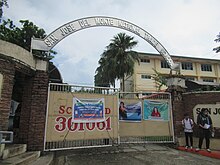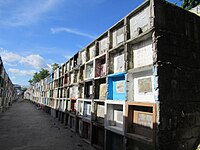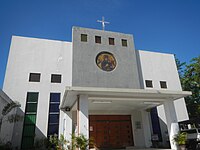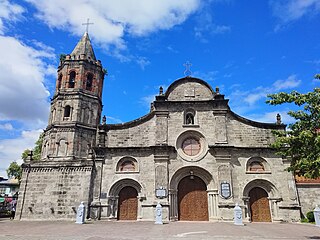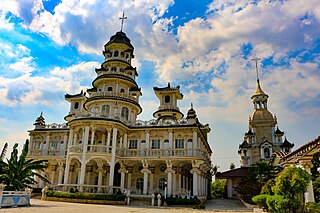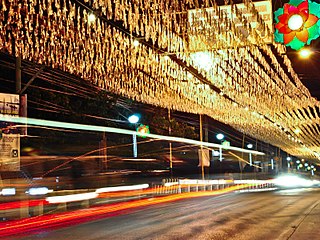This article needs additional citations for verification .(August 2010) |
San Jose del Monte | |
|---|---|
| City of San Jose del Monte | |
(From top, left to right : Our Lady of Lourdes Grotto Shrine • St. Joseph the Worker Church • SM City San Jose del Monte View Deck • New City Hall and River Esplanade • Mount Balagbag • People's Park & Sports Complex) | |
| Nickname(s): The Rising City, Balcony of the Metropolis, The First City of Bulacan | |
| Motto: Arya San Joseño! | |
| Anthem: San Jose del Monte Hymn | |
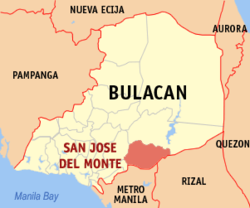 Map of Bulacan with San Jose del Monte highlighted | |
Location within the Philippines | |
| Coordinates: 14°48′50″N121°02′43″E / 14.8139°N 121.0453°E | |
| Country | Philippines |
| Region | Central Luzon |
| Province | Bulacan |
| District | Lone district |
| Founded | March 2, 1752 |
| Cityhood | September 10, 2000 |
| Lone district | December 18, 2003 |
| Named for | Saint Joseph |
| Barangays | 59 (see Barangays) |
| Government | |
| • Type | Sangguniang Panlungsod |
| • Mayor | Arthur B. Robes |
| • Vice Mayor | Efren C. Bartolome Jr. |
| • Representative | Florida P. Robes |
| • City Council | Members |
| • Electorate | 261,740 voters (2022) |
| Area | |
| • Total | 105.53 km2 (40.75 sq mi) |
| Elevation | 122 m (400 ft) |
| Highest elevation | 1,179 m (3,868 ft) |
| Lowest elevation | −1 m (−3 ft) |
| Population (2020 census) [3] | |
| • Total | 651,813 |
| • Density | 6,200/km2 (16,000/sq mi) |
| • Households | 156,871 |
| Demonym | San Joseño |
| Economy | |
| • Income class | 1st city income class |
| • Poverty incidence | 15.49 |
| • Revenue | ₱ 2,183 million (2020) |
| • Assets | ₱ 4,120 million (2020) |
| • Expenditure | ₱ 1,957 million (2020) |
| • Liabilities | ₱ 1,054 million (2020) |
| Utilities | |
| • Electricity | Meralco |
| • Water | San Jose Del Monte City Water District |
| • Telecommunications | Globe Telecom Smart Communications Dito Telecommunity |
| Time zone | UTC+8 (PST) |
| ZIP code | 3023, 3024 |
| PSGC | |
| IDD : area code | +63 (0)44 |
| Native languages | Tagalog |
| Catholic diocese | Diocese of Malolos |
San Jose del Monte, officially the City of San Jose del Monte (abbreviated as SJDM or CSJDM; Filipino : Lungsod ng San Jose del Monte), is a 1st class component city in the province of Bulacan, Philippines. According to the 2020 census, it has a population of 651,813 people, making it the largest local government unit within the province of Bulacan and Central Luzon, and the 18th most populated city in the Philippines.
Contents
- Etymology
- History
- Cityhood
- Geography
- General Land Use
- Climate
- Barangays
- Demographics
- Economy
- Agriculture
- Livestock and poultry
- Trade and commerce
- Tourism
- Infrastructure
- Transportation
- Water
- Power
- Telecommunications/communications
- Education
- Public Universities
- Colleges
- Public high schools
- Government
- Local government
- Government officials (2022-2025)
- Congress representation
- List of former municipal and city mayors
- Gallery
- Notable personalities
- References
- External links
It was proclaimed as a component city on September 10, 2000, through Republic Act No. 8797. Its conversion into a highly urbanized city was by the virtue of Proclamation No. 1057 issued by President Rodrigo Duterte on December 4, 2020; the conversion was rejected on a referendum held on October 30, 2023, by the voters of Bulacan including the concerned city. [5]
Located in the southeast of the province, it is bordered by the cities of Caloocan and Quezon City in Metro Manila to the south, by the town of Rodriguez in Rizal to the east, the towns of Santa Maria and Marilao to the west and Norzagaray to the north. San Jose del Monte is 65 kilometres (40 mi) from Malolos and 30 kilometres (19 mi) from Manila.
The city is home to some of the biggest resettlement areas in the Philippines like the Sapang Palay resettlement area spread over 36 barangays, Pabahay 2000 in Barangay Muzon South, and Towerville in Barangay Minuyan Proper. Most of the city's population come from former informal settlers along the creeks, esteros, riverbanks and railway tracks of Metro Manila. [6]
























